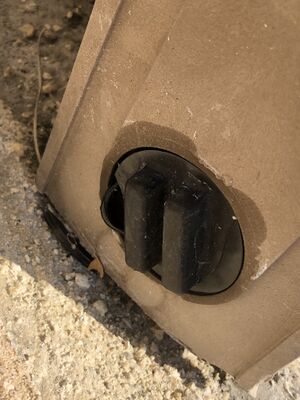| Line 3: | Line 3: | ||
An O-ring is a doughnut shaped ring molded from an elastomer. | An O-ring is a doughnut shaped ring molded from an elastomer. | ||
| − | Most O-rings we see in pools are Buna N 55 hardness. | + | The basic core polymer of an elastomeric compound is called a rubber, produced either as natural gum rubber in the wild, on commercial rubber plantations or manufactured synthetically by the chemical industry. Most O-rings we see in pools are Buna N 55 hardness. |
For more details about O-Rings see the [https://www.parker.com/content/dam/Parker-com/Literature/O-Ring-Division-Literature/ORD-5700.pdf Parker O-Ring Handbook] | For more details about O-Rings see the [https://www.parker.com/content/dam/Parker-com/Literature/O-Ring-Division-Literature/ORD-5700.pdf Parker O-Ring Handbook] | ||
| Line 9: | Line 9: | ||
[https://www.youtube.com/watch?v=aweDWuNkPw0 O-Rings? O-Yeah! How to Select, Design, and Install O-Ring Seals] is a great video about O-Rings. | [https://www.youtube.com/watch?v=aweDWuNkPw0 O-Rings? O-Yeah! How to Select, Design, and Install O-Ring Seals] is a great video about O-Rings. | ||
| − | Many O-rings are a commodity and can be found at hardware stores for much less then when packaged by a pool company. | + | Many O-rings are a commodity and can be found at hardware stores for much less then when packaged by a pool company. The advantage to paying pool company prices is you know you are getting the correct size O-Ring with the required materials. |
O-rings sit in a groove (or gland) and seal through compression. Any joint sealing with an O-ring should nor be over-tightened. Over-tightening an O-ring joint can deform the O-ring and lead to leaks. Hand tighten unions with an O-ring and do not use a wrench to tighten them. | O-rings sit in a groove (or gland) and seal through compression. Any joint sealing with an O-ring should nor be over-tightened. Over-tightening an O-ring joint can deform the O-ring and lead to leaks. Hand tighten unions with an O-ring and do not use a wrench to tighten them. | ||
Revision as of 20:33, 24 December 2022
O-rings are used throughout a pools plumbing to create watertight seals. You find large O-rings sealing the joints of filter to small O-rings sealing rotating valve stems. O-rings are used to create water tight seals around threaded fittings.
An O-ring is a doughnut shaped ring molded from an elastomer.
The basic core polymer of an elastomeric compound is called a rubber, produced either as natural gum rubber in the wild, on commercial rubber plantations or manufactured synthetically by the chemical industry. Most O-rings we see in pools are Buna N 55 hardness.
For more details about O-Rings see the Parker O-Ring Handbook
O-Rings? O-Yeah! How to Select, Design, and Install O-Ring Seals is a great video about O-Rings.
Many O-rings are a commodity and can be found at hardware stores for much less then when packaged by a pool company. The advantage to paying pool company prices is you know you are getting the correct size O-Ring with the required materials.
O-rings sit in a groove (or gland) and seal through compression. Any joint sealing with an O-ring should nor be over-tightened. Over-tightening an O-ring joint can deform the O-ring and lead to leaks. Hand tighten unions with an O-ring and do not use a wrench to tighten them.
If a fitting with an O-ring is leaking do not simply crank it down to try and stop the leak. That can crack the union, or pipe, or further deform the O-ring. Open up the joint and examine the O-ring for nicks, cracks or deterioration. Replace the O-ring if it is damaged or has lost its flexibility and is deformed.
Below shows a filter drain plug that was overtightened and the O-ring deformed:
All O-rings seal better when Pool Lube is used on them. Pool Lube should be used on all new O-rings and small leaks can often be stopped with an application of Pool Lube.


